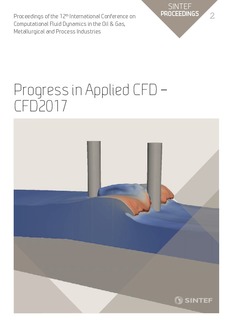| dc.contributor.author | Kamath, Satish | |
| dc.contributor.author | Padding, Johan T. | |
| dc.contributor.author | Buist, Kay A. | |
| dc.contributor.author | Kuipers, J.A.M. | |
| dc.date.accessioned | 2018-01-28T14:46:16Z | |
| dc.date.available | 2018-01-28T14:46:16Z | |
| dc.date.issued | 2017 | |
| dc.identifier.isbn | 978-82-536-1544-8 | |
| dc.identifier.issn | 2387-4295 | |
| dc.identifier.uri | http://hdl.handle.net/11250/2480056 | |
| dc.description.abstract | Bubble columns are widely used in the chemical industry because of their simple design and high efficiency. The scale-up of these kinds of columns is challenging and time-consuming. Since high throughput is targeted, they are operated in the heterogeneous bubbling regime where the flow is complex and turbulent. Large-scale bubble columns can in principle be simulated using continuum models (TFM/MFM) with closures from more detailed models such as Front Tracking (FT) or Volume of Fluid (VOF). Multi-fluid models are capable of predicting the flow field, but to accurately describe mass transfer rates, an accurate interfacial area of the bubbles is required as well as mass transfer coefficients for dense bubble swarms. This requires the MFM to be coupled with models that can predict bubble size distributions. The Discrete Bubble Model (DBM) can be scaled up but the bubble-bubble interactions make it computationally very intensive. Stochastic Direct Simulation Monte Carlo (DSMC) methods treat the bubbles in a discrete manner while more efficiently handling the collisions compared to the DBM. The DSMC model has earlier been used for very small particles in the size range of Angstroms to microns where the particles are purely inertial at high Stokes numbers. In the work of Pawar et al. (2014) this was used for micrometer sized particles/droplets where this method proved to be 60 to 70 times faster than more classical methods like the Discrete Particle Model (DPM). In this work the DSMC method has been extended to finite sized bubbles/particles in the order of millimeters. A 4-way coupling (liquid-bubble-bubble) is achieved using the volume-averaged Navier Stokes equations. The model is verified first for monodisperse impinging particle streams without gas. Then the model is verified with the DBM of a 3D periodic bubble driven system. The collision frequencies are all within 10 percent accuracy and the speed up achieved per DEM time step is nearly 10 times compared to the DBM, which facilitates simulation of large systems. | nb_NO |
| dc.language.iso | eng | nb_NO |
| dc.publisher | SINTEF Academic Press | nb_NO |
| dc.relation.ispartof | Proceedings of the 12th International Conference on Computational Fluid Dynamics in the Oil & Gas, Metallurgical and Process Industries | |
| dc.relation.ispartofseries | SINTEF Proceedings;2 | |
| dc.subject | Euler-Lagrange methods | nb_NO |
| dc.subject | Bubble dynamics | nb_NO |
| dc.subject | Optimization | nb_NO |
| dc.subject | Stochastic methods. | nb_NO |
| dc.subject | DSMC | nb_NO |
| dc.title | Stochastic DSMC model for large scale dense bubbly flows | nb_NO |
| dc.type | Chapter | nb_NO |
| dc.type | Conference object | nb_NO |
| dc.type | Peer reviewed | nb_NO |
| dc.description.version | publishedVersion | nb_NO |
| dc.subject.nsi | VDP::Technology: 500 | nb_NO |
